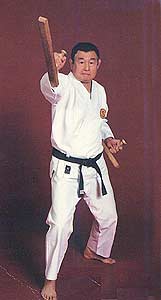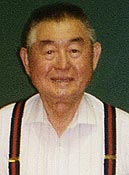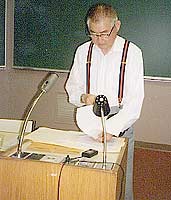Memories Of Richard Kim
By Christopher Caile

On November 8, Richard Kim, Hanshi, known affectionately to many as O'Sensei,
passed away. He was 83 years old. The world has lost another great master.
Kim was not my teacher and I was not part of his organization, but
over a few years I got to know him quite well. What follows are some
of my personal memories of Kim, and reflections on how and what he
taught me and many others. Hopefully this will give you a sense of
the man. I will leave it to others to adequately detail his life.
Kim is best known for his books "The Weaponless Warriors", "The
Classical Man," and the series " Kobudo - Okinawan Weapons
Series 1-3." For years his column "The Classical Man" was
featured in Karate Illustrated. He was also a teacher to thousands
of students through his Zen Bei Busen organization which has approximately
one hundred martial arts schools across the United States, Canada and
Europe.
I had the honor of building a relationship with Kim that began in
1991. It started with a letter to him about the history of some kata.
We had a lot in common including the arts we had studied and many teachers
we had both known, and thus we often spoke. Soon afterwards he invited
me to meet him at his summer camp held annually in Guelph, Ontario,
not too far from where I lived. Over the next eight years I got to
know Kim quite well.
 If
you met Kim on the street, the image of a karate master would be the
farthest thing from your mind. His hair cut short in a crew cut and
dressed with a bow tie and suspenders, he looked more like an accountant
or professor.
If
you met Kim on the street, the image of a karate master would be the
farthest thing from your mind. His hair cut short in a crew cut and
dressed with a bow tie and suspenders, he looked more like an accountant
or professor.
I found Kim to be very open, someone who genuinely wanted to help
others. He had a huge, generous heart, with no sense of arrogance about
him. When talking to him, he talked to you as an equal, with total
concentration. You always went away feeling somehow acknowledged. This
was a great gift.
Kim's personality also had a lightness about it, a youthfulness of
heart. Despite his age, he had a joyful spontaneity and enthusiasm
-- especially when discussing the martial arts that he loved.
What really struck a listener, however, was his knowledge. He was
the ultimate Classical Man. He was also brilliant. He had a Ph.D.,
and was fluent in five languages. It was often recounted that in his
youth he had gone directly from the third to the seventh grade, graduated
college by the age of 18 and earned his Ph.D. not long afterwards.
As a teacher he was a living encyclopedia of martial arts information
and history, someone who had lived in Japan and China and knew Okinawa
and Asia. More than one martial arts authority has said that Kim was
the most knowledgeable person on the martial arts that they had ever
known.
Concept Of Kata
|
|
|
Sensei Kim on the Guelph
College Campus accompanied by his long time friend and
associate, Sensei Leong.
|
|
|
|
Sensei Kim teaching a kata
seminar
|
|
|
|
Sensei Kim teaching a sai
technique
|
|
Kim ran summer and winter camps that were attended by hundreds of
students drawn from his many affiliated karate dojos plus an occasional
guest, such as myself. From our many conversations at camp always came
the unexpected -- added information, untold stories, explanations and
insights. He liked the stimulation and it got him off the track of
his usual stories that he had told so many times before.
Kim's daily summer camp schedule began at dawn with Tai Chi and the
basics of Pa qua (a Chinese internal martial art) along with deep breathing
exercises. After breakfast there would be a seminar, each day focusing
on a different kata. But there was always more -- kata applications,
concepts of strategy, distancing and body alignment, pressure points,
exercises in movement, kicking techniques taken from Muay Thai, center
line theory, punching exercises from boxing as well as joint locks
from Daito-ryu -- an almost overwhelming mix that somehow Kim related
back to the kata or subject of the day.
While most karate organizations teach specific renditions of kata,
Kim taught different renditions of the same kata drawn from their original
teachers. This provided a unique historical perspective, something
that not only provided insight on the development of kata itself, but
also taught students something about the master from whom the kata
were drawn. In all over 70 empty hand and weapons kata were taught.
Kim believed, however, that the essential kata were few -- Chinto,
Bassai, Seisan, Gojushiho and Konku. "They are all that are necessary
to know to become a karate master," he would often say.
One unifying element that ran through all of Kim's teaching was the
acknowledgment of the importance of spirit. It was part of his teaching
of technique and kata just as it was the center of his many nightly
lectures, although in his lectures the concept of spirit took many
forms.
Kim used kata as the principal method of teaching karate. He felt,
however, that in the West much of the understanding of karate kata
had been lost. His teacher, Yoshida Kotaro, had said, "kata was
a way to reach the silence between the thoughts."
Kim often related karate kata to the classical sword arts (kenjutsu). "In
kenjutsu there is a moment of truth when you actually face death," he
would say, "something that is lost in kendo and other modern 'do'
arts."
"In karate kata you can kill your opponent in your mind. You
can't do this practice fighting," he would say. "In kata
when you hear 'Yoi' (prepare), you fully commit yourself to give up
your life in your mind. You become committed to death."
Reaching this higher spiritual plain comes through training in kata,
within which you train for life and death. When people begin karate
training it is all physical. At that level, when sparring, the strongest
always win. At the higher level, however, spirit becomes more important.
If you can give up your life and are willing to die, this provides
a tremendous advantage, for in battle you must break the other's spirit.
And, Kim would often add, "Never fight with someone committed
to die in battle."
Those who have written about kata in the West, Kim said, usually do
not understand its full meaning. They often quote the saying, "There
is no first attack in karate" (Karate ni sente nashi). But this
is only a beginning level of understanding. Real karate and kata is
to train your intuition, to respond to the intention of attack with
a full blitzkrieg of techniques.
"Thus kata deals with the most primeval element - kill or survive," he
would say. "You must practice it with full commitment. You must win." This
is the truth of life and death combat. "The winner in war is always right," something
that seems brutal, he would say, but is the truth.
Thus when you begin kata, Kim would say, you must transport yourself
onto the field of combat -- see, feel and smell the enemy and the attacks
-- act as if each second were your last -- totally commit to action.
This is "Karate ni sente hissho" - "hissho" meaning "guaranteed
to win."
Karate masters, Kim would say, learn to go into an Alpha brain wave
state -- a state in which you lose yourself and become totally attuned
to your environment and your attacker -- in which you become one with
the enemy and intuitively connected to his every nuance.
Recently when Peter Urban (an American pioneer of Goju ryu karate
and former student of Kim and Gogen Yamaguchi) was asked what the most
valuable thing was that he had learned from Kim, he answered, "My
value system." When asked "what belief system?" he replied, "Today
is now."
Urban was also asked to sum up his training with Kim in the early
1950's. Urban answered with a single word: "Uncompromising."
Spirit And Health
At summer camp during evening lectures, Kim's focus often changed.
He complemented the daytime physical aspects of his teaching (techniques
and kata) with comprehensive discourses on the esoteric and spiritual
side of karate.  Kim
often said, "Developing spirituality is the unique contribution
of the martial arts."
Kim
often said, "Developing spirituality is the unique contribution
of the martial arts."
The ultimate goal of Kim's teaching was, I believe, to help his students
build a strong, positive and healthy spirit while nurturing the body
internally for health and long life. Toward this end Kim prompted his
students to develop an ego free attitude -- to look at the world from
a larger perspective, to have an open mind, positive attitude, flexible
outlook and spiritual source of strength.
Kim understood the intimate connection between mind, body and spirit,
and he taught his students how to use their minds to mold their attitude,
outlook and spirit and to harness the energies of the body (chi) for
health and healing. He also taught how the subconscious mind could
be used to program the self towards any end. His goal was to provide
simple and useful tools for his students to strengthen their spirit,
change their lives, and mold their minds.
On this journey of self-discovery Kim guided his students through
a travel log of subjects and insights. While sometimes controversial,
he was also riveting. He would regale you with stories of Zen masters,
tales of famous samurai, Zen teachers and his own World War II episodes.
Everything was punctuated with Kim's sense of humor, an occasional
chuckle and ability to laugh at himself. Sometimes Kim's jokes were
bit off color, but the humor and the sparkle in his eyes were always
present.
There were so many stories, verbal snap shots of great budo masters
with whom he had associated -- of Shanghai, China, and about his teachers
and stories of Chojun Miyagi (the founder of Goju karate) who had studied
at the Shanghai Martial Arts Academy (where Kim visited during WWII
while serving in the Japanese army) -- of Yokahama, Japan, where Kim
met a young Peter Urban and guided him to study karate and not boxing
(Kim was Urban's first karate teacher) -- of Okinawa and Kim's tales
of Gichen Funakoshi and Hohan Soken using visualizations in their practice
-- of Tokyo, Japan and Mas Oyama and Kim's stories of Oyama's strength
and his ability to bend a coin between two fingers.
I always wondered if Kim's focus on helping his own students with their lives,
spiritually and physically, resulted from a very personal trial. He often spoke
of his wife having survived cancer. She believed, he said, that healing required
three mental ingredients: A fighting spirit, a willingness to learn and change,
and a spiritual resource, such as a belief in God. "These change your
mental vibrations."
While Kim respected modern medicine, he also had some healthy skepticism,
believing much was not yet understood -- that Western doctors did not
fully understand nutrition or the power of the mind and that much of
what that goes on in medicine today is not all scientific, but a little
magical too.
About nutrition Kim said many things. He believed in the importance
of reducing red meat in the diet, and taking herbs and supplements.
But his cardinal rule was, "If you have 70% fruits and vegetables
in your diet, the other 30% doesn't matter."
Kim also believed, at least in part, that illness reflected the body's
state of energy and that when the life force was disturbed or not properly
flowing, illness would result. He also understood various energies
as vibrations -- sounds, emotions, prayer, external and internal energies
-- things that could be harnessed to affect the energies of the body.
Kim would say that everyone inside had kindling, and if you pull energy
into your body and concentrate, you will produce a glow of energy.
He taught how to circulate this energy, balance the endocrine system,
use the "Six Healing Sounds", use colors for healing and
many other techniques. He also discussed the body's Chakra system and
how to use its energy.
Kim was a strong believer in the power of the subconscious. He would
say that we live in energy. The subconscious brain (right) is its source,
something that never rests, and the conscious brain (left) can communicate
with it. If the subconscious is programmed it will work for you. Thus,
you can create yourself through your own thought -- but to do so you
must achieve an Alpha state (brain wave) to communicate. He would say "You
are in charge. It is the most important thing in your life. If you
give yourself an order your body will follow."
Kim also often talked about the power of thought -- how thought influenced
or prompted emotions, and that every emotion was communicated throughout
the body (by neuropeptides) and affected every cell in the body. He
would say, "To heal you must emotionally generate the right neuropeptides
to open the lock to healing."
Buddha taught, he said, that "Everything begins and ends in thought," to
which he often added, "So, what you plant in your head is what
you get."
One of Kim's concepts that I always liked was how words affect our
very lives and future. He would often summarize this in the following:
"Words become actions.
Actions become habits.
Habits become character.
Character becomes destiny."
I always viewed Kim's teachings as a natural balance (yin and yang).
The hard physical martial arts were balanced with the softness of internal
spirit, discipline and self-regulated health. Kim's goal, I think,
was to promote the development of a balanced and total human being.
Words Of Wisdom
Here are a few of the many sayings that I enjoyed from Kim over the
years. I took them from my notes. I believe they are his own words,
but Kim may have taken the words from other sources. I think the first
one was adapted from the Bible:
"The secret of life and karate is to see what you really see."
"If you can change the way you see the world, the world will
be different. This is a lot easier than changing the world."
"The first step in discipline is to delay gratification."
"In Kata you must go where fire can't, and weapons can't hurt
you."
"All of us carry our raft today that we crossed the river with
yesterday."
I learned a lot from you, Richard Kim. Along with many others I will
miss your advice, your knowledge and your spirit.
Acknowledgments:
I would like to thank Don Warrener and Masters Publications
for several photos used in this article. I would also like to thank
Debbie Bilton, Eileen Dennis and Barbara Smith for their many helpful
suggestions on what to include in this article.
About The Author:
Christopher Caile is the Founder and Editor-In-Chief of FightingArts.com.
He has been a student of the martial arts for over 40 years and holds
a 6th degree black belt in Seido Karate and has experience in judo,
aikido, diato-ryu, boxing and several Chinese fighting arts. He is
also a long-term student of one branch of Traditional Chinese Medicine,
Qigong. He is a personal disciple of the qi gong master and teacher
of acupuncture Dr. Zaiwan Shen (M.D., Ph.D.) and is Vice-President
of the DS International Chi Medicine Association. In Buffalo, NY,
he founded the Qi gong Healing Institute and The Qi Medicine Association
at the State University of New York at Buffalo. He has also written
on Qi gong and other health topics in a national magazine, the Holistic
Health Journal and had been filmed for a prospective PBS presentation
on Alternative Medicine. Recently he contributed a chapter on the
subject to an award winning book on alternative medicine, "Resources
Guide To Alternative Health."